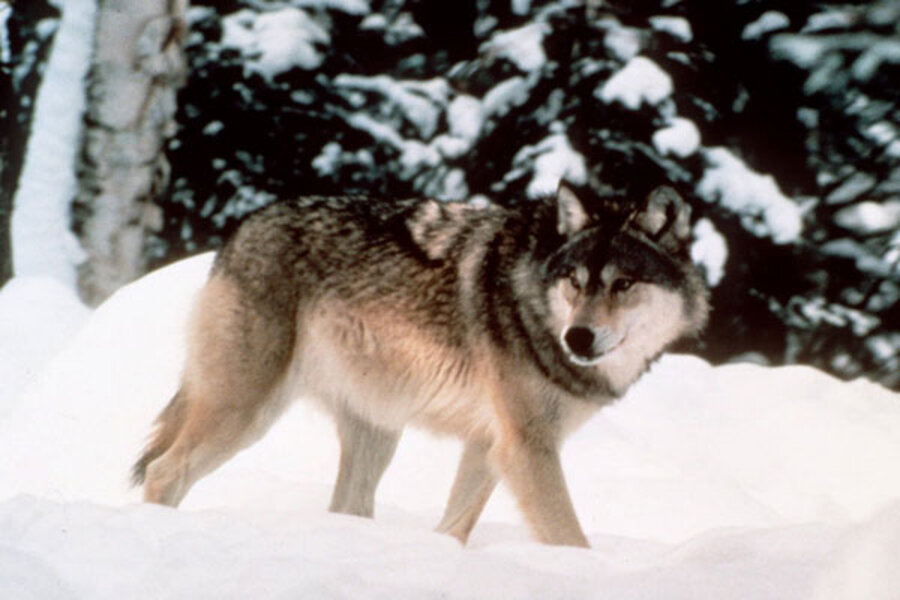Open season: Will rebounding Wyoming wolves thrive without US protection?
Loading...
The decision Friday by the US Fish and Wildlife Service to lift endangered species protections for the gray wolf in Wyoming is a testament to the success of the 20-year federal wolf reintroduction effort.
But the move also opens the door to a bloodier era in which Americans will be emboldened to challenge encroaching packs and lone wolves to protect property and livestock.
The return of the gray wolf continues to rivet the Mountain West, where some 2 million wolves roamed before settlers drove them to extinction by the 1930s. Nearly 2,000 animals and more than 100 breeding pairs – a tiny fraction of their original numbers – now traverse the ancestral valleys and ridgelines of their northern Rockies range.
Along with reintroduced animals in Montana, Wyoming, and Idaho, states like Michigan, Minnesota, Oregon, and Washington have also seen naturally migrating wolf populations growing steadily larger, even as hundreds of animals have been culled for intruding on domesticated herds.
“The return of the wolf to the northern Rocky Mountains is a major success story, and reflects the remarkable work of states, tribes, and our many partners to bring this iconic species back from the brink of extinction," Fish and Wildlife Service Director Dan Ashe said in a statement.
Reintroduction of wolves into the heart of American ranch country became one of the defining dramas of the 1990s, pitting agriculture-controlled state legislatures against environmentalists and federal scientists. More deeply, it pitted the symbolism of the wolf as a reminder of a lost wilderness against the pragmatic reality of the intelligent animal’s predation of domesticated animals.
Today, ethicists and conservationists balk at lifting federal protections, especially in Wyoming, where the state will test a new “dual status” designation. It means wolves in national parks, like Yellowstone, will be protected, while any animals that roam outside protected areas can be shot on sight as nuisance or as “trophy game,” with no bag limits imposed on hunters.
The latest wolf count in Wyoming showed a total of 328 wolves, 224 of which have set up ranges outside Yellowstone National Park.
But even as the wolf hunt is set to step up in America’s wildest reaches, it’s also true that ranchers, who firmly opposed federal wolf reintroduction as it gained steam in the 1980s and '90s, have slowly come to accept the wolf’s return as inevitable and permanent.
The trapping and shooting of wolves by humans, rancher associations say, is in itself an important conservation measure, forcing the animals to be wary of human populations and pushing them to stay in the wilder, unpopulated reaches of the mountains.
“The reality is my folks aren't in any big rush to get there to try to kill a wolf. They just want the ability to protect their livestock," Bryce Reece, president of the Wyoming Wool Growers Association, tells The Associated Press. "We are hopeful, by putting some pressure on them, they'll move back into areas where it's less habited and there's less livestock."
Animal ethicists have been fretting for decades about the moment when Washington steps away from the wolf packs it has reintroduced to the West, and whether the conservation framework is sturdy enough to protect the interests of both wolves and humans.
Reintroduction “presents a unique opportunity for reflection about the ethical issues involved in wolf restoration and the development of practical models for how humans can learn to coexist with wolves in an increasingly humanized landscape,” write the authors of “A New Era for Wolves and People,” a treatise on the ethics of wolf reintroduction.
For some in the West, however, the idea of peaceful wolf-human existence remains a pipe dream. “Natural balance is a Walt Disney movie – it isn’t real,” David Allen, president of the Rocky Mountain Elk Foundation, said recently.
Concerned about such attitudes, environmental groups have fought against dropping the endangered designation, saying that Congress has already allowed preemptive wolf hunts, which, if expanded, could once again drive the animals to the brink of extinction. Environmentalist groups have vowed to try to block the new Wyoming hunts in the courts.
"Wyoming's open season on wolves in almost all of the state would allow aerial gunning of wolves and even killing wolf pups in their den," Earthjustice attorney Jenny Harbine told CNN. "These policies could drive wolves back into local extinction."
To be allowed to continue to manage the wolves, Wyoming officials must ensure population levels of at least 150 wolves and 15 breeding pairs. Federal wildlife officials will keep an eye on the wolf populations in Wyoming, Montana, and Idaho for five years to make sure the animals continue to thrive. If not, the wildlife service can once again make them an endangered species.






